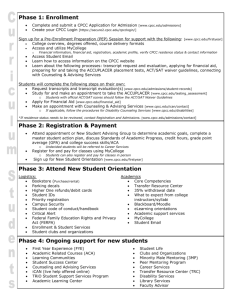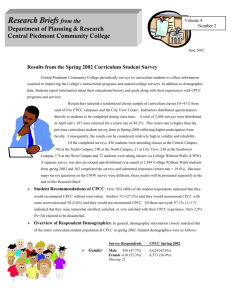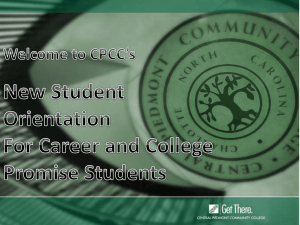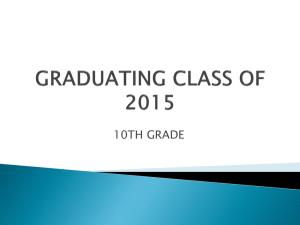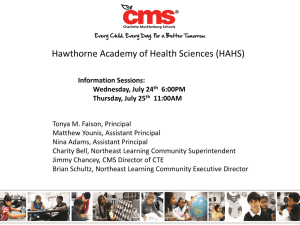1 June 2000 Results from the Spring 2000 Curriculum Student
advertisement
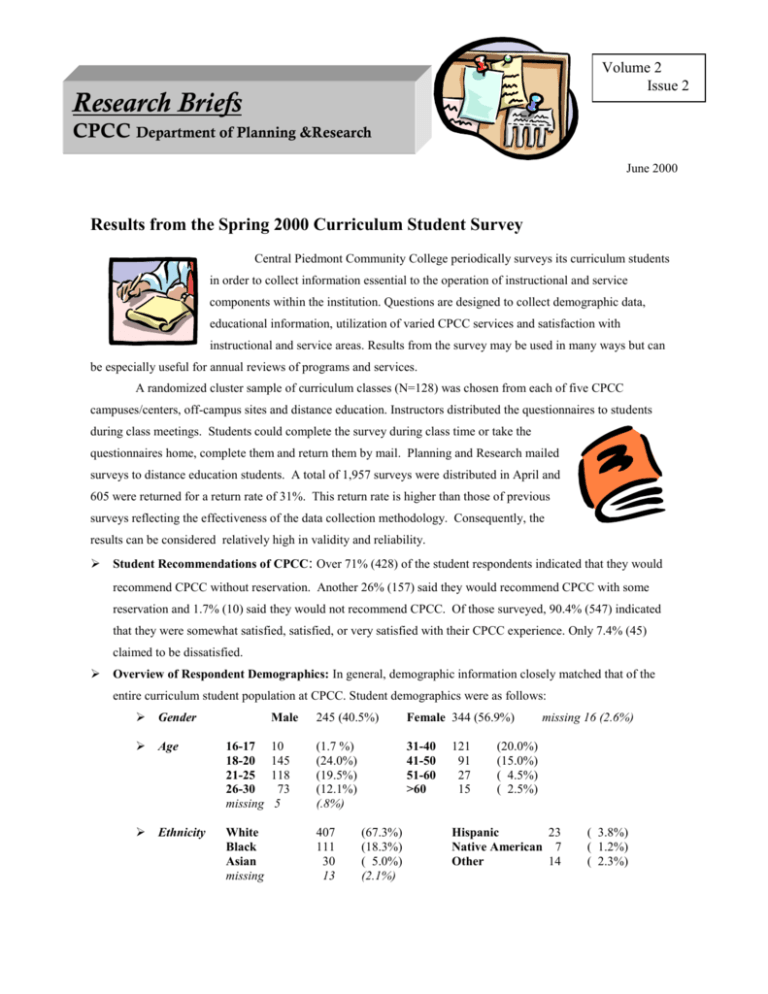
Volume 2 Issue 2 Research Briefs CPCC Department of Planning &Research June 2000 Results from the Spring 2000 Curriculum Student Survey Central Piedmont Community College periodically surveys its curriculum students in order to collect information essential to the operation of instructional and service components within the institution. Questions are designed to collect demographic data, educational information, utilization of varied CPCC services and satisfaction with instructional and service areas. Results from the survey may be used in many ways but can be especially useful for annual reviews of programs and services. A randomized cluster sample of curriculum classes (N=128) was chosen from each of five CPCC campuses/centers, off-campus sites and distance education. Instructors distributed the questionnaires to students during class meetings. Students could complete the survey during class time or take the questionnaires home, complete them and return them by mail. Planning and Research mailed surveys to distance education students. A total of 1,957 surveys were distributed in April and 605 were returned for a return rate of 31%. This return rate is higher than those of previous surveys reflecting the effectiveness of the data collection methodology. Consequently, the results can be considered relatively high in validity and reliability. Student Recommendations of CPCC: Over 71% (428) of the student respondents indicated that they would recommend CPCC without reservation. Another 26% (157) said they would recommend CPCC with some reservation and 1.7% (10) said they would not recommend CPCC. Of those surveyed, 90.4% (547) indicated that they were somewhat satisfied, satisfied, or very satisfied with their CPCC experience. Only 7.4% (45) claimed to be dissatisfied. Overview of Respondent Demographics: In general, demographic information closely matched that of the entire curriculum student population at CPCC. Student demographics were as follows: Gender Age 16-17 18-20 21-25 26-30 missing Ethnicity White Black Asian missing Male 245 (40.5%) Female 344 (56.9%) 10 145 118 73 5 (1.7 %) (24.0%) (19.5%) (12.1%) (.8%) 31-40 41-50 51-60 >60 407 111 30 13 (67.3%) (18.3%) ( 5.0%) (2.1%) 121 91 27 15 missing 16 (2.6%) (20.0%) (15.0%) ( 4.5%) ( 2.5%) Hispanic 23 Native American 7 Other 14 ( 3.8%) ( 1.2%) ( 2.3%) 2 The majority of current student respondents were female (56.9%), white (67.3%), under 30 (57.3%) and employed full or part-time (82.5%). Economic Indicators for Students Education of Students Prior to Attending CPCC Students were asked to indicate their level of education prior to attending CPCC. Approximately 3% of students surveyed were dually or concurrently enrolled high school students. An additional 32.2% had some college credit when they came to the college and 23.3% had already earned some type of college degree (associate, bachelors, masters, doctorate) prior to attending CPCC. Education Level Less than 12 years High school diploma/GED Some college Associate degree Bachelors degree Masters degree Some graduate school Doctorate or professional degree Missing Number (Percent) 18 (3.0%) 243 (40.2%) 195 (32.2%) 34 ( 5.6%) 67 (11.1%) 19 ( 3.1%) 11 ( 1.8%) 10 ( 1.7%) 8 ( 1.3%) Education Level of Students' Parents When asked about the educational level of their parents/guardians, 40.5% of fathers/male guardians and 34.6% of mothers/female guardians were college graduates or had attended graduate degrees. The survey also indicated that 37.5% of fathers/male guardians had never attended college and 40.0% of mothers/female guardians had never attended college. Number and percent by education levels of both fathers and mothers is as follows: Father/male guardian Less than 12 years High school grad/GED Some college College graduate Graduate school/degree Don’t' know Missing 88 139 113 139 72 34 20 Mother/female guardian (14.5%) (23.0%) (18.7%) (23.0%) (11.9%) ( 5.6%) ( 3.3%) 74 168 131 136 56 17 23 (12.2%) (27.8%) (21.7%) (22.5%) ( 9.3%) ( 2.8%) ( 3.8%) Upon further examination, it was determined that 56.2% of students' fathers had not graduated from college and 61.7% of students' mothers had not graduated from college. When these were combined, the survey revealed that: 50.6% of CPCC curriculum students were first generation college students (neither parents had graduated from college). Current Employment Status Students were asked about their employment status. It was found that 83.5% of curriculum students worked full or part time. Numbers and percents by employment category are as follows: Full time (40 hrs. or more per week) Part-time (21-39 hrs. per week) Part-time (less than 20 hrs. per week) Unemployed Missing 289 142 68 100 6 (47.8%) (23.5%) (11.2%) (16.5%) (1.0%) 3 Students' Personal Annual Salary Students were asked to indicate their personal (not household or family) income. It was found that 42% of CPCC students earn less than $20,000 per year and 22.1% earn more than $40,000 per year. Number and percent by income level are as follows: Income Level Less than $ 10,000 $10 - 19,999 $20 - 29,999 $30 - 39,999 $40 - 49,999 more than $50,000 missing Number (Percent) 151 (25.0%) 103 (17.0%) 110 (18.2%) 61 (10.1%) 54 ( 8.9%) 80 (13.2%) 46 ( 7.6%) Goal in Attending CPCC Students could indicate multiple goals from the list below. Of those surveyed, 63.1% were credentialseeking students (intending to obtain a two year degree, certificate or diploma). Responses indicated that 53.1% of students were transfer students (intending to take classes or complete a degree and transfer to a fouryear school). Responses also indicated that 57.9% of students had job-related goals (to improve job-related skills for their current / new job, obtain a degree and enter workforce, improve reading, writing and math). An additional 18.5% of students indicated they were taking courses for personal interest. Number and percent by stated goal are as follows: Goal Statement Obtain 2 yr. degree and transfer to a 4 yr. school Obtain 2 yr. degree and enter the workforce Take courses and transfer to a 4 yr. College Personal interest/enrichment Prepare for a different job Update skills for current job Obtain a diploma or certificate Improve reading, writing and math skills Prepare for first job Number (Percent) 170 (28.1%) 158 (26.1%) 151 (25.0%) 112 (18.5%) 84 (13.9%) 73 (12.1%) 54 ( 8.9%) 23 ( 3.8%) 12 ( 2.0%) Emerging Student Profiles When analyzing student education level, goal statement, income level and employment status, two distinct curriculum students profiles emerge: Profile 1 Students: This group represents 44% of curriculum students and resembles traditional college students. These students come to the college with a high school degree/GED or less, and the majority are under 25. Approximately 60% earn less than $20,000 per year (40% earn less than $10,000). They attend the college to obtain a degree, certificate or diploma (72.5%) and 58.3% want to transfer to a four-year institution. When asked about jobs, 86.5% of these students are working full/part-time. Less than 30% indicate they are here to update skills, for personal interest or to prepare for a job. Profile 2 Students: This group represents 56% of curriculum students and could be described as non-traditional. These students come to the college with some college coursework, an associate, bachelors, masters or doctorate. The majority are over 25 years old. Sixty-five percent make more than $20,000 per year and 31.9% make more than $40,000 per year. They take courses to update job skills, prepare for a different job and for personal interest (58.1%). An additional 22.6% indicate they want to take a few courses and transfer (possibly pre-requisites for masters or doctoral work). Fewer want to earn a degree, certificate or diploma (56.8%) and 80.7% are working full or part time. 4 Location of Class Attendance Students indicated all the campuses and times when and where they were currently attending classes. It was found that 53.4% of respondents attended classes at the Central campus, 24.3% at South, 19.5% at North, 4% at City View, 6.9% at Southwest. College Without Walls and off-campus locations accounted for 12.% and 5.3% respectively. As campuses are developed, more CPCC students are attending classes at more than one campus (College Without Walls was counted as a virtual campus.) Number of campuses attended are as follows: Number (Percent) of Campuses Attended 449 (74.2%) attend classes at only one campus 126 (20.8%) attend classes at two campuses 23 (3.8%) attend classes at three campuses 3 (.5%) attend classes at four campuses 1 (.2%) attend classes at five campuses Responses also indicated that 60.3% of students attended classes during the day, 60.7% attended at night and 11.9% on the weekend. Of those students, 25.5% were attending both day and night classes and 3.3% were attending classes at all three times, during the day, night and on the weekend. Factors in determining the decision to attend CPCC. Students were asked to rate factors they felt were important in their decision to attend CPCC. The factors are ranked below in order of most importance to least importance: % Scoring Factor as Important Class schedules that allow for work Academic courses/programs offered Low tuition costs Convenient locations Easy transfer of credits Relevance to job Academic reputation Small class sizes Appearance of grounds/facilities Availability of financial aid Availability of job placement/counseling Availability of coops, internships, etc. Admission regardless of grades Accessibility by public transportation 78.0% 77.7% 75.2% 76.7% 62.8% 53.1% 50.9% 49.1% 36.4% 32.7% 30.9% 28.3% 28.3% 12.6% Satisfaction with Instructional Elements of the College Students were asked to rate their satisfaction with various elements of CPCC instruction from (1) very unsatisfied to (5) very satisfied. The instructional items in terms of percent satisfied are rank ordered as follows: Quality of instruction Classroom facilities Availability of instructors Campus/site where classes were offered Library resources Times classes are offered Quality of faculty advisor Availability of classes % Satisfied (Somewhat to very) Item Mean 87.6% 86.7% 86.1% 80.6% 77.5% 83.9% 73.6% 83.0% 3.90 3.79 3.71 3.64 3.64 3.63 3.55 3.51 5 In general, student respondents were satisfied with the instructional elements at CPCC. Satisfaction with Student Support Services Students were asked to rate their satisfaction with student support services from (1) very unsatisfied to (5) very satisfied. Overall, student respondents were satisfied with service areas at CPCC. Student Services areas are rank ordered from most satisfied to least satisfied as follows: Satisfaction w/ Services Computer labs CPCC.CC.NC.US Registration services Telephone information Records/transcripts Testing/assessment center Academic Learning/Tutoring Instructional labs Welcome/information center Library Security Bookstore Student career services Student life activities Parking Food service/vending Counseling/advisement Financial aid % Satisfied user population N/(somewhat to very) (408) 92.9% (426) 92.7% (522) 92.9% (435) 91.0% (404) 91.1% (409) 90.5% (308) 92.2% (378) 89.8% (401) 91.5% (427) 88.5% (455) 88.1% (531) 89.7% (265) 90.9% (267) 88.0% (532) 80.1% (424) 80.8% (398) 79.0% (231) 73.5% Item Mean 4.03 4.00 3.95 3.84 3.83 3.82 3.81 3.80 3.79 3.79 3.78 3.76 3.74 3.65 3.59 3.45 3.43 3.27 Satisfaction with Areas Considered Most Important to Students The Current curriculum Survey asked students to make two assessments of college services. First they were asked to rate the importance of various college services to them as students from (1) unimportant to (4) very important. This assessment was done to help the college determine its performance gaps between what students consider important and their satisfaction with those services. If students do not consider a service to be important, chances are they do not use it and have little or no opinion in regard to satisfaction. The college can focus on student satisfaction with services students deem most important to them. The following services are rank ordered in terms of most important to least important to students. The mean satisfaction score for those students who rated services as important or very important are listed below: 6 Service Area % ranking item important or very important Mean satisfaction score CPCC.CC.NC.US Computer labs Registration services Testing/assessment centers Welcome/information center Academic Learning/Tutoring Telephone information Instructional labs Records/transcripts Student career services Bookstore Library Student life activities Security Food service/vending Parking Counseling/advisement Financial aid 63.3% (n=383) 68.2% (n=413) 81.6% (n=494) 62.5% (n=378) 55.6% (n=336) 51.7% (n=313) 63.9% (n=387) 62.9% (n=381) 64.0% (n=387) 49.2% (n=298) 79.0% (n=478) 69.9% (n=423) 38.0% (n=230) 77.6% (n=469) 40.0% (n=242) 88.5% (n=535) 60.7% (n=367) 40.3% (n=244) 4.19 4.13 4.10 3.97 3.96 3.96 3.96 3.96 3.94 3.88 3.86 3.86 3.85 3.85 3.61 3.60 3.58 3.51 In general, student satisfaction was higher for students for whom services were important than for those for whom services were not important. Considering only the students for whom services were important, the most highly rated student service areas in terms of satisfaction were: the web page computer labs registration services Communication of Information to Students Students were asked to identify important factors associated with the ability to be informed about courses and programs at CPCC. Not surprisingly, the class schedule and the college catalog topped the list. Important Schedule of classes College catalog Internet CPCC web page Circulars mailed to you Newspaper ads Articles in the newspaper Television ads High school counselor Radio ads High school teacher 459 (75.9%) 424 (70.1%) 303 (50.1%) 200 (33.1%) 160 (27.8% 157 (26.0%) 109 (18.0%) 103 (17.0%) 100 (16.5%) 85 (14.0%) 7 Student Satisfaction by Campus Students were able to indicate the campus where they attended classes. Many students took classes at more than one campus so the numbers at each campus do not add to the total (n=606). The demographic profile of student respondents by campus is as follows: Central South North Southwest City View Off-campus n=323 n=143 n=117 n=42 n=51 n=31 Gender: Male 40.1% Female 59.9% 44.1% 55.9% 53.0% 47.0% 59.5% 40.5% 16.3% 83.7% 45.2% 54.8% Age: < 21 21-30 31-40 41-50 >50 36.1% 31.3% 19.0% 8.8% 4.8% 37.3% 25.4% 18.6% 13.6% 4.2% 16.7% 30.9% 31.0% 16.7% 4.8% 2.0% 21.9% 15.6% 21.9% 34.4% 6.3% 21.9% 15.6% 21.9% 34.4% Students: 22.9% 37.5% 19.2% 13.6% 6.2% Students were asked to rate their satisfaction with instructional areas of the college according to a likerttype scale with (1) indicating very unsatisfied and (5) indicating very satisfied. Means by campus are listed below: Instructional Area Central South North Southwest City View Off-campus Availability of classes Availability of instructors Campus/site where classes are offered Classroom facilities Library resources Quality of faculty advisors Quality of instruction Times classes are offered 3.58 3.75 3.61 3.85 3.21 3.47 3.29 3.74 3.82 4.09 3.74 3.34 3.70 3.59 3.77 3.85 4.15 3.59 3.11 3.77 3.37 3.69 3.97 3.11 4.14 3.95 4.14 3.70 3.37 3.39 3.52 3.84 3.59 3.71 3.94 3.83 3.24 3.81 3.28 3.71 3.97 3.72 4.10 4.33 3.58 3.06 3.55 3.67 Overall, students were satisfied with elements of instruction across the campuses. Students were also asked to rank their satisfaction with various student and campus services. Mean scores by campus are as follows:. Service Area Central South North Southwest City View Off-campus Learning/Tutoring Bookstore Computer Labs CPCC Webpage Counseling/Advisement Financial Aid Food Services/Vending Instructional Labs Library Parking Records/Transcripts Registration Services Security Student Life/Activities Student Career Services Telephone Information Testing Center Welcome Center 3.79 3.85 3.95 4.03 3.38 3.17 3.35 3.86 3.97 3.27 3.76 3.95 3.64 3.61 3.81 3.78 3.84 3.81 4.00 3.85 4.16 4.11 3.84 3.71 3.50 3.78 3.72 4.11 4.05 4.07 4.02 3.69 3.87 3.92 3.93 3.92 3.58 3.56 4.00 3.89 3.21 3.13 3.69 3.75 3.65 3.60 3.73 3.84 3.75 3.73 3.41 3.83 3.71 3.69 3.42 3.52 4.09 3.76 3.17 2.71 3.27 3.75 3.11 3.97 3.83 3.79 4.00 3.00 3.31 3.56 3.36 3.33 3.96 3.95 4.14 3.80 3.75 3.61 3.50 3.93 4.03 3.76 3.80 4.09 3.82 3.93 3.93 3.90 4.03 3.97 2.50 3.41 3.64 3.86 2.88 2.67 3.08 3.00 3.50 3.55 3.50 3.64 3.88 3.50 4.00 3.52 3.67 3.27 8 Student satisfaction with services varied slightly across campuses with students at City View and South ranking most areas slightly higher than students at other campuses and students at Southwest and Off-campus sites ranking areas slightly lower than other campuses. Considering that many of the above listed services are not regularly available at many campuses, students may be dissatisfied with the lack of service available rather than the service itself. More in-depth assessment may need to be done in certain areas at certain campuses. Distance Education and Student Satisfaction: This survey also utilized a sample of College Without Walls Students to determine the relative importance of various student services to distance education students and their satisfaction with those services. Twenty-nine classes of distance education students were selected and surveys were mailed to 439 distance education students. Of those, 72 surveys were returned producing a return rate of 16.4%. Demographic characteristics of those students are as follows: Gender: Race: White African American Hispanic Age: Male < 21 41-50 8.1% 21.6% 30.6% Female 76.7% 12.3% 5.5% Asian Native American Other 21-30 > 50 69.4% 33.8% 6.8% 0 2.7% 2.7% 31-40 Employment Status of Students: Unemployed Employed Part-time (<20 hours per week) Employed Part-time (>20 hours per week) Employed Full-time 27.0% 10.8% 18.9% 43.2% Annual Personal Income Level Less than $10,000 $10,000-19,999 $20,000-29,999 $30,000-39,999 $40,000-49,999 more than $50,000 19.7% 15.5% 22.5% 19.7% 5.6% 16.9% Previous Education Level of Student Prior to Attending CPCC Less than 12 years 1.4% High School Diploma/GED 27.0% Some College 44.6% Associate Degree 5.4% Bachelors Degree 10.8% Masters Degree 4.1% Some Graduate School 2.7% Doctorate/Professional Degree 4.1% 28.4% 9 Goal in Attending CPCC (students could select more than one answer) Obtain 2 yr. degree and transfer to a 4 yr. school 36.5% Obtain 2 yr. degree and enter the workforce 18.9% Take courses and transfer to a 4 yr. College 32.4% Personal interest/enrichment 18.9% Prepare for a different job 17.6% Update skills for current job 9.5% Obtain a diploma or certificate 6.8% Improve reading, writing and math skills 2.7% Prepare for first job 2.7% Distance education students are slightly different that other students at CPCC. CWW students are older, more are female, fewer are minority, fewer are working, they have higher personal income and they are more educated when they come to the college. More CWW students are interested in transferring to a four-year college/university. It was also found that CWW students were taking a distance education course but most were also taking a traditional course at one of the CPCC campuses. Numbers and percents were as follows: Campus Number taking classes Percent taking classes Central South North Southwest City View Off-campus 41 19 12 3 2 3 55.4% 25.7% 16.2% 4.1`% 2.7% 4.1% Only 13 (17.6%) of CWW students were taking only a distance education course and attending no additional campus. The majority (60.8%) were attending classes at only one additional campus and 18.9% were attending classes at two additional campuses. Students were asked to rate their satisfaction with elements of instruction on the same likert-type scale. Several additional elements of instruction were assessed for distance education than were for traditional classroom students. The mean scores of CWW students for instructional areas are rank-ordered from most satisfied to least satisfied as follows: Satisfaction with Elements of Instruction: Quality of instruction Availability of instructors Classroom facilities Library resources Format in Which Classes are Offered Availability of classes Location for Materials Pick-up Technical Facilities Quality of faculty advisor Times classes are offered Campus/site where classes were offered % Satisfied (Somewhat to very) Item Mean 97.1% 92.8% 90.8% 89.1% 87.5% 85.7% 85.5% 83.6% 83.6% 83.3% 80.3% 3.95 3.64 3.75 3.78 3.84 3.43 3.65 3.62 3.45 3.58 3.45 Overall, CWW students were satisfied with elements of instruction. However, with the exception of "quality of instruction", CWW students ranked elements of instruction slightly lower than did traditional classroom students. 10 It is critical that service for College Without Walls students be evaluated since many of them utilize services on-line or via telephone. Students were asked to rate students/college services according to the same likerttype scale. The mean scores of CWW students for students/college service areas are rank-ordered from most satisfied to least satisfied as follows: Satisfaction with Student Services: CPCC.CC.NC.US Computer labs Academic Learning/Tutoring Telephone information Registration services Student career services Records/transcripts Library Testing/assessment center Instructional labs Welcome/information center Bookstore Security Student life activities Food service/vending Counseling/advisement Financial aid Parking % Satisfied (somewhat to very) Item Mean 96.9% 97.4% 92.9% 94.6% 92.3% 100% 94.2% 89.1% 92.6% 87.5% 95.9% 91.4% 89.7% 94.4% 81.2% 73.3% 73.1% 73.1% 4.20 4.14 4.12 4.06 4.02 4.00 3.96 3.93 3.92 3.84 3.84 3.78 3.72 3.71 3.51 3.28 3.25 3.23 Overall, College Without Walls students were satisfied with student/college services. CWW students rated student/college services slightly higher than traditional classroom students. Results Overall, students were satisfied with instructional elements of the college and with student/college services. With increasing enrollments at the new and proposed campuses being critical, it is important that the college determine the satisfaction levels of all students (Curriculum, Corporate and Continuing Education and Basic Skills/Literacy.) Therefore, Planning and Research has begun a rotating three year cycle of assessing student satisfaction with programs of study and college services. This year's assessment focused on Curriculum students. The 2000-2001 survey will focus on students in the Basic Skills/Literacy area and the following year, Corporate and Continuing Education students will be surveyed. This cycle of assessment will continue on a rotating basis. A complete copy of the survey results may be obtained from the Planning & Research Web site: http://inside:cpcc.cc.nc.us/planning/default.htm


